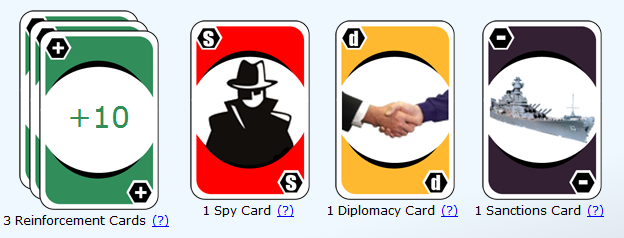Hurray for new features! On Sunday, October 30th at 1am PDT (8am GMT), WarLight will be upgraded to 1.08.0. While the upgrade is taking place, the website will be down. If all goes well, the downtime should last for less than an hour.
This blog post contains a summary of what’s changing.
Open Seat Prerequisites improvements
Open Seat Prerequisites is a feature that allows game creators to define requirements that players must meet in order to join their game on the Open Games tab.
In 1.08, game creators can set prerequisites on player’s win ratios in ranked games. For example, you could add a prerequisite that only allows players that win at least 60% of their ranked 1v1 games to join your game. This is a great for when you want to play an open game, but want to try to find players who are closer to your own skill level.
Music
WarLight now contains a soundtrack which plays in the background. It can easily be turned on or off in the top-right corner, just like how the sound effects work. It will default to ON on the single-player tab, and OFF on the multi-player tab, but if you turn it on or off yourself it will stay that way. It won’t be present on any other tabs.
The music is the same song featured in the stand-alone client. It’s called Heroic Return by Chris Haigh.
Templates now store invited players
After 1.08, when you save a game template, the list of players you invited to that game are now stored along with it. This is great for players who create games from templates, as it means they don’t need to re-enter the list of invited players every time.
For example, say you add a few open seats to a game on one team, and an AI and your friend Bob onto another team, then save that as a template. When you load up the template, all of the open seats, AIs, and Bob will be pre-populated into the invite list so you don’t have to add them again.
This also makes it easier to create rematches. You can open up the settings for a game, click the template name or the word “Custom” if no template was used, then click the button to create a new game with the same settings. After 1.08, all of the players from that game will be pre-populated into the list, so you can easily create a new game with the same people.
Blacklist Improvements
The blacklist is a list of players that you don’t want to play WarLight with. In 1.08, the blacklist is getting a few improvements:
- Players you have blacklisted get a small “B” icon next to their name. This appears not only next to places where their name shows up, but also in the small boxes that you see when browsing the Open Games tab. This makes it much easier to avoid joining games with players you might not want to play with.
- When a player you’ve blacklisted sends chat message to a game or tournament you’re in, the chat will be hidden from view so you don’t have to read it. If you do want to see what they said, a link is provided to reveal it.
Notable Victories
When viewing a player’s ladder page, a new section now shows the player or team’s victories over the strongest opponents they’ve ever beaten. This is a quick way to view that player’s best accomplishments. The strongest opponents are determined by the best rank that the opponent has ever achieved.
Misc Changes
– Game archival system. See the previous blog post for full details.
– Added a “Active games or unread chat” filter to the My Games page.
– The report dialog has been improved to provide more information and reduce false reports.
– Players can now elect to hide their shortened e-mail from other players.
– Fixed a bug that was preventing players from viewing an opponent’s cards if they had a fog game open when it ended.
– Fixed a bug in the map designer that caused some objects to appear in the wrong location when SVG matrix transformations were used.
– The map designer now gives a better error message if players try to make a SVG group a player-controllable territory.
– Fixed a bug that caused games won during territory selection to say “Won in -1 turns” on the My Games page.
– Fixed a bug that caused an attack order’s tooltip to not update when the attack changed.
– Game graphs now default to All Turns instead of Last 10 Turns


